|
Visiting the Nakazato Kiln
Unbroken lineage of fourteen generations
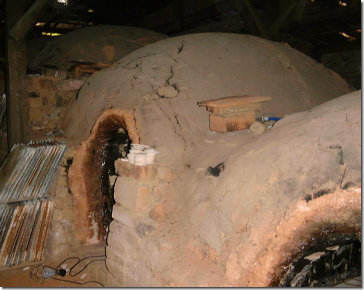
Three-chambered noborigama kiln
Karatsu is one of Japan's best-loved pottery styles. Like other styles, it derives its name from the city it's located in. Karatsu, meaning "China Port," is located in Saga Prefecture on the island of Kyushu. Karatsu pottery traces its roots back to the 15th century, but it is generally agreed that it matured in the latter half of the 16th century. This is due to the influx of Korean potters brought back by Lord Hideyoshi in what is often called the "pottery wars." Tea was favored among the lords at that time, with a Karatsu chawan being a most desired style, two other cherished styles being Raku and Hagi. The only family dating back to that time still in the Karatsu pottery world is the famous Nakazato family. They have an unbroken lineage of fourteen generations and are one reason of the continued success of the Karatsu style.
|
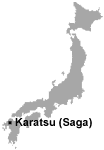 Karatsu is accessible from Hakata station in Fukuoka and takes a little over an hour by train. The Nakazato Museum is at Karatsu, Machida 3-6-29. Open daily from 9:00am to 5:30 pm. Karatsu is accessible from Hakata station in Fukuoka and takes a little over an hour by train. The Nakazato Museum is at Karatsu, Machida 3-6-29. Open daily from 9:00am to 5:30 pm.
TEL: 0955-72-8171
 |
|
Just a short walk from Karatsu station is the studio-museum-gift shop of the head of the Nakazato family -- he is always given the family potting name of Taroemon (Ta-row-eh-moan). Today we have Nakazato Taroemon XlV (formally known as Tadahiro), who took the Taroemon name on March 4, 2002. His father is now known as Houan.
The Taroemon Lineage:
I. Matashichi d.1663
II. Taroemon d.1670
III. Jin'emon d.1703
IV. Taroemon d.1744
V. Kiheiji d.1757
VI. Taroemon d.1786
VII. Toji d.1811
VIII. Taroemon d.1817
IX. Shohei d.1825
X. Totaro d.1892
XI. Tenyu d.1924
XII. Taroemon (Muan) d.1985
XIII. Taroemon (Houan)
XIV. Taroemon
It was through the great efforts of Taroemon XII (designated a Living National Treasure in 1976) that Karatsu regained its popularity in modern times, for the style suffered a long decline during the 18th and 19th centuries owing to the loss of official clan patronage, the onslaught of foreign ways, and declining interest in Tea during the Meiji Period. In the early 1930s, a revival of Tea wares occurred at many pottery centers in Japan, reinvigorating many lost traditions. During this time, Hagi regained popularity thanks in large part to Miwa Kyuwa (formerly Kyusetsu IX). Kaneshige Toyo led the charge for Bizen, while the major forces for the rejuvenation of Mino traditions were Arakawa Toyozo and Kato Tokuro.
The Nakazato Taroemon Compound
The compound has a very traditional gateway and as soon as one passes through it a large Daruma is there to greet you (see photos below).
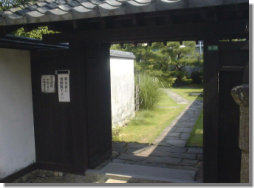
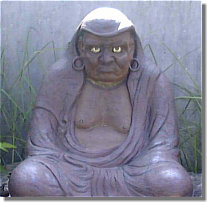
Up the stairs takes you into the showroom where all the different styles of Karatsu are on display -- there are about eight (click here for a list of Karatsu types). The production line does differ from the works made by Taroemon himself, not only in quality and style but in price as well.
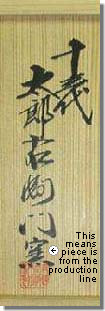 A word of caution about boxes for collectors. All boxes at the kiln are signed Taroemon and the generation -- the current being the fourteenth. If there is the kanji for "kiln" also signed on the box, it is a production-line work and not from the hands of Taroemon himself. A word of caution about boxes for collectors. All boxes at the kiln are signed Taroemon and the generation -- the current being the fourteenth. If there is the kanji for "kiln" also signed on the box, it is a production-line work and not from the hands of Taroemon himself.
The photo of the box cover (at right) indicates that the piece is a production-line piece.
The Taroemon kiln is a big business with a large staff -- about twenty for the kiln alone -- in the showroom and in the studio. An original Taroemon work will not, as mentioned above, have the kanji for kiln displayed on the box.
In the below four photos, we see the current Taroemon himself throwing a piece, a worker sanding off some kiln grit from a large Ao-Karatsu tsubo, a kiln potter forming the foot on a tea cup, and some dishes that were left outside to dry in the sun.
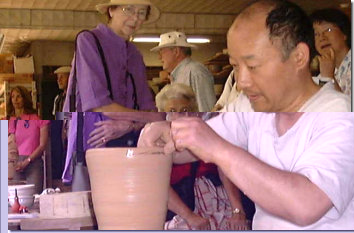
Taroemon XIV throwing a piece

Another grinding day at the kiln
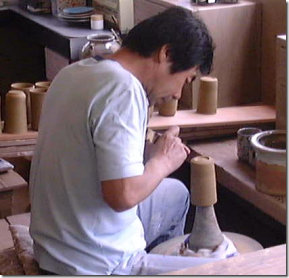
Foot forming
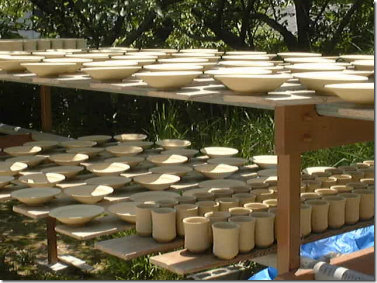
Pieces drying outdoors
Through a narrow hallway from the showroom is where the museum can be found. It's actually a small room with four glass cases housing older works, known as Ko-Karatsu, and recent works by past and current Taroemon.
Johanna Becker in her fine book on Karatsu writes: "Too much skill is evident on Karatsu ware to call it rustic; too much freedom and spontaneity to call it sophisticated. Its style lies somewhere between these poles. The undisguised display of natural materials -- the clay and its textures, glazes and designs applied rapidly and freely, crackled and pocked glazes, untrimmed foot rims and irregular shapes -- makes Karatsu immediately appealing to the senses without demand or pretension."
In the museum are such works, like those presented below:
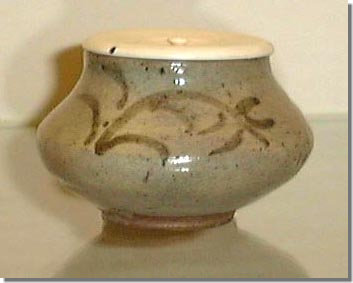
Ko-Karatsu Chaire

Ko-karatsu Chawan
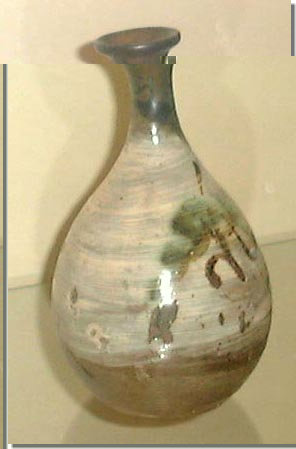
Ko-Karatsu Pine Tokkuri
One of the reasons for all the pine designs on Karatsu pots is, quite naturally, the many pine trees in the Karatsu area. Below is a shot of the pine trees in the garden of the lovely
Yoyokaku Inn.

The Nakazato kiln used these days is a traditional noborigama (see photo at top of this page). It's a three-chambered kiln and fired once a month for about two days. In the old days the Ochawangama (see below photo) was used and is now a shrine on the Nakazato property. It's a short walk from the museum through a small path.
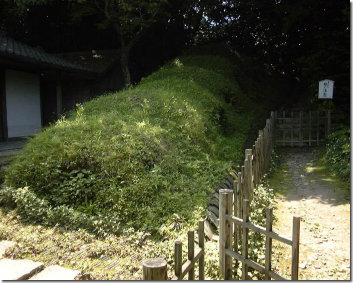
The old Ochawangama kiln is now a shrine
The plaque outside this old kiln reads:
The Tojin-machi Ochawangama is a multi-chambered climbing kiln located in Karatsu City at 1324-5 chome, Choda. The kiln measures 27.5 meters in length. The fire box, walls and ceiling of the kiln's surviving seven dome-shaped chambers are still in good condition. The first chamber is small and acts as the main fire box. Each successive chamber increases in height, length and width. According to the diary of Nakazato Kiheiji (5th generation potter), in 1615, the first Daimyo of the Karatsu Han (feudal domain), Terasawa Hirotaka, named Fukumoto Yasaku, Oshima Hikoemon and Nakazato Matashichi as makers of official ceramic wares for the domain. They were given a stipend to fire the wares once a year at the Shiinomine Kiln in Minami-Kitahata.
In 1707, the 4th generation Nakazato Taroemon and Oshima Yabei, under Karatsu Han orders, built a new kiln at Bozu-machi, Karatsu City. In 1734, the 5th generation Nakazato Kiheiji and Oshima Yakichi again by domain decree rebuilt the Ochawangama at Tojin-machi (present day 5 chome, Choda), Karatsu City. The successive generations continued to produce official wares until the abolishment of the feudal system at the beginning of the Meiji Era (1868-1912). Although they lost their official status, the Nakazato family continued to fire this kiln until the end of the Taisho Era (1912-1926).
The pottery made at the official kilns was called Kenjo Karatsu ware. They were mostly wares for tea ceremony, a wide range of tableware and objects for the alcove. A typical Kenjo Karatsu design would be an inlaid cloud-and-crane pattern and many wares were made to resemble blue-and-white porcelain.
The Nakazato family is one of Japan's greatest treasures and is one reason for the wonderful ceramic traditions that abound here today.

What is Karatsu?
See Our Guidebook !
|